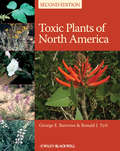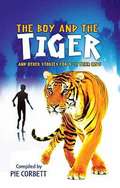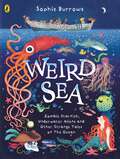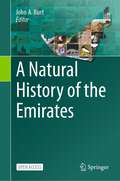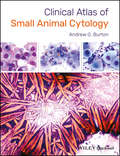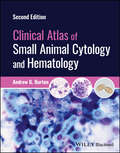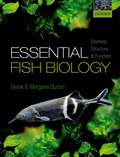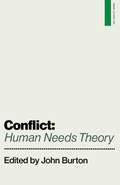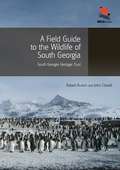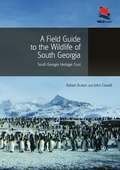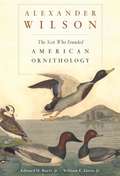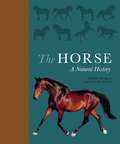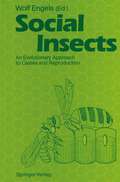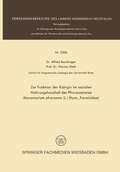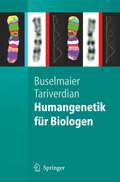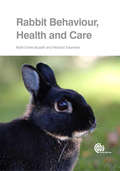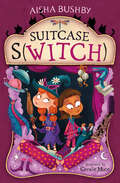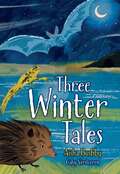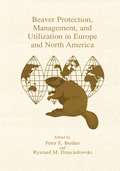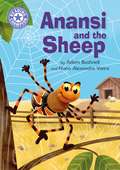- Table View
- List View
Toxic Plants of North America
by George E. Burrows Ronald J. TyrlToxic Plants of North America, Second Edition is an up-to-date, comprehensive reference for both wild and cultivated toxic plants on the North American continent. In addition to compiling and presenting information about the toxicology and classification of these plants published in the years since the appearance of the first edition, this edition significantly expands coverage of human and wildlife—both free-roaming and captive—intoxications and the roles of secondary compounds and fungal endophytes in plant intoxications. More than 2,700 new literature citations document identification of previously unknown toxicants, mechanisms of intoxication, additional reports of intoxication problems, and significant changes in the classification of plant families and genera and associated changes in plant nomenclature. Toxic Plants of North America, Second Edition is a comprehensive, essential resource for veterinarians, toxicologists, agricultural extension agents, animal scientists, and poison control professionals.
Toxic Plants of North America
by George E. Burrows Ronald J. TyrlToxic Plants of North America, Second Edition is an up-to-date, comprehensive reference for both wild and cultivated toxic plants on the North American continent. In addition to compiling and presenting information about the toxicology and classification of these plants published in the years since the appearance of the first edition, this edition significantly expands coverage of human and wildlife—both free-roaming and captive—intoxications and the roles of secondary compounds and fungal endophytes in plant intoxications. More than 2,700 new literature citations document identification of previously unknown toxicants, mechanisms of intoxication, additional reports of intoxication problems, and significant changes in the classification of plant families and genera and associated changes in plant nomenclature. Toxic Plants of North America, Second Edition is a comprehensive, essential resource for veterinarians, toxicologists, agricultural extension agents, animal scientists, and poison control professionals.
The Boy and the Tiger and other stories for 9 to 11 year olds (Pie Corbett's Storyteller)
by Ray Burrows Corrine BurrowsDon't just read - read aloud! With a treasure-trove of favourite tales, each accompanied by an audio retelling from a professional storyteller, this book gives children the perfect opportunity to read aloud, listen along, follow text, read together and do all the things they need to build their literacy skills! They'll meet tigers, giants and much more in this captivating collection.
Weird Sea: Zombie Starfish, Underwater Aliens and Other Strange Tales of the Ocean
by Sophie Burrows'From the supernatural to the sublime, Weird Sea really is the weirdest of world tours and it is BRILLIANT!' The Little Literacy SocietyWhat does the sea make you think of? Crashing waves, crumbling sandcastles . . . maybe a squawking seagull or two? Well, how about . . .Ghost ships! Mega sharks! The Bermuda triangle! Zombie starfish! Psychic sea serpents! And don't even get us started on something called the Hot Tub of Despair . . .You see, the sea is actually weird. Really weird. Not only is it full of amazing creatures and mini monsters, some of the world's most mind-blowing myths and legends revolve around the sea too.So what are you waiting for? Come with our wonderful narrator, Shrimpy, and dive into some of the incredible secrets of our weird, wonderful and totally wild oceans.Filled with brilliant facts and myths as well as hilarious illustrations in beautiful full colour, Weird Sea is the perfect gift for little explorers who can't wait to tell you DID YOU KNOW? and is the perfect antidote to boring kids non-fiction.
A Natural History of the Emirates
by John A. BurtFor many people, thoughts of the United Arab Emirates conjure images of ultramodern skyscrapers and rolling sand dunes. However, the Emirates are a rich mosaic of ecosystems and habitats that support surprisingly diverse communities of organisms, and there is growing awareness of the importance of these previously underappreciated natural assets. A Natural History of the Emirates provides a comprehensive overview of the unusual environmental setting of this young nation, and surveys the major ecosystems and the marine and terrestrial organisms occurring across the nation. From freshwater streams in the hyperarid Hajar Mountains to the world’s most temperature-tolerant coral reefs, the UAE is home to an astounding variety of uniquely adapted organisms that are providing insights into climate change and how organisms cope with and respond to extreme environmental conditions. The book closes with a section on human interactions with this unique environment, and proposes initiatives to ensure the protection of these unique natural assets into the future. This is an open access book.
Clinical Atlas of Small Animal Cytology
by Andrew G. BurtonClinical Atlas of Small Animal Cytology provides an essential guide for interpreting cytologic samples to diagnose small animal patients. Features photographs of diseases with a diagnosis confirmed by pathognomonic cytologic features, histopathology, special stains, microbial culture, or other confirmatory tests Emphasizes characteristic features of each disease and distinguishing features Provides multiple images to differentiate cells from lesions that could look similar Presents more than 500 representative high-quality images
Clinical Atlas of Small Animal Cytology
by Andrew G. BurtonClinical Atlas of Small Animal Cytology provides an essential guide for interpreting cytologic samples to diagnose small animal patients. Features photographs of diseases with a diagnosis confirmed by pathognomonic cytologic features, histopathology, special stains, microbial culture, or other confirmatory tests Emphasizes characteristic features of each disease and distinguishing features Provides multiple images to differentiate cells from lesions that could look similar Presents more than 500 representative high-quality images
Clinical Atlas of Small Animal Cytology and Hematology
by Andrew G. BurtonClinical Atlas of Small Animal Cytology and Hematology A comprehensive image-based reference to all aspects of small animal cytology and hematology, including sample collection and handling Clinical Atlas of Small Animal Cytology and Hematology, Second Edition is an essential, comprehensive resource for all veterinary professionals preparing and evaluating cytology and blood samples. Featuring hundreds of large, high-quality images, this fully updated new edition provides an even more extensive collection of exceptional photomicrographs, accompanied by detailed descriptions, figure legends and annotations to guide readers through the diagnostic process. The Second Edition adds an extensive new hematology section, new chapters detailing sample acquisition and preparation, and many new diseases across all chapters. Each section provides a detailed description of the microscopic appearance, clinical considerations, and prognosis for each disease, using a bullet point format to promote rapid review for efficient, evidence-based clinical decision making. Clinical Atlas of Small Animal Cytology and Hematology features: More than 750 high-quality cytology and hematology images 6 new chapters, including detailed sections on sample acquisition and the preparation and staining of cytology and hematology slides A comprehensive hematology section including an easy-to-follow blood smear interpretation guide, and detailed chapters describing erythrocytes, leukocytes, platelets and background features Updated cytology sections with new diseases and images in all chapters Easy to use, with superior quality images and detailed yet succinct clinical information, Clinical Atlas of Small Animal Cytology and Hematology is a powerful resource to help improve confidence and skill in the interpretation of cytology and hematology samples, and in turn positively impact patient care and outcomes.
Clinical Atlas of Small Animal Cytology and Hematology
by Andrew G. BurtonClinical Atlas of Small Animal Cytology and Hematology A comprehensive image-based reference to all aspects of small animal cytology and hematology, including sample collection and handling Clinical Atlas of Small Animal Cytology and Hematology, Second Edition is an essential, comprehensive resource for all veterinary professionals preparing and evaluating cytology and blood samples. Featuring hundreds of large, high-quality images, this fully updated new edition provides an even more extensive collection of exceptional photomicrographs, accompanied by detailed descriptions, figure legends and annotations to guide readers through the diagnostic process. The Second Edition adds an extensive new hematology section, new chapters detailing sample acquisition and preparation, and many new diseases across all chapters. Each section provides a detailed description of the microscopic appearance, clinical considerations, and prognosis for each disease, using a bullet point format to promote rapid review for efficient, evidence-based clinical decision making. Clinical Atlas of Small Animal Cytology and Hematology features: More than 750 high-quality cytology and hematology images 6 new chapters, including detailed sections on sample acquisition and the preparation and staining of cytology and hematology slides A comprehensive hematology section including an easy-to-follow blood smear interpretation guide, and detailed chapters describing erythrocytes, leukocytes, platelets and background features Updated cytology sections with new diseases and images in all chapters Easy to use, with superior quality images and detailed yet succinct clinical information, Clinical Atlas of Small Animal Cytology and Hematology is a powerful resource to help improve confidence and skill in the interpretation of cytology and hematology samples, and in turn positively impact patient care and outcomes.
Essential Fish Biology: Diversity, Structure, and Function
by Derek Burton Margaret BurtonEssential Fish Biology provides an introductory overview of the functional biology of fish and how this may be affected by the widely contrasting habitat conditions within the aquatic environment. It describes the recent advances in comparative animal physiology which have greatly influenced our understanding of fish function as well as generating questions that have yet to be resolved. Fish taxa represent the largest number of vertebrates, with over 25,000 extant species. However, much of our knowledge, apart from taxonomy and habitat descriptions, has been based on relatively few of them , usually those which live in fresh water and/or are of commercial interest. Unfortunately there has also been a tendency to base our interpretation of fish physiology on that of mammalian systems, as well as to rely on a few type species of fish. This accessible textbook will redress the balance by using examples of fish from a wide range of species and habitats, emphasizing diversity as well as recognizing shared attributes with other vertebrates.
A Field Guide to the Wildlife of South Georgia (WILDGuides #107)
by Robert Burton John CroxallSouth Georgia is rich in wildlife and spectacular scenery, and it is a prime destination spot on most Antarctic tours. This beautifully illustrated field guide depicts the birds, mammals, insects, flowering plants, and other vegetation found in this unique part of the world. It features 368 full-color photographs of more than 180 species, including 65 species of birds, 20 species of sea mammals, nearly 60 species of insects, and more than 40 species of flowering and nonflowering plants. Detailed species accounts describe key identification features, with information on status, behavior, threats, and distribution. This one-of-a-kind photographic guide also includes introductory chapters on South Georgia's geography, climate, ecology, and conservation.Features 368 photos of more than 180 species Covers birds, sea mammals, insects, and plants Provides detailed species accounts Includes chapters on geography, climate, ecology, and conservation The only photographic field guide to focus specifically on South Georgia
A Field Guide to the Wildlife of South Georgia (PDF)
by Robert Burton John CroxallSouth Georgia is rich in wildlife and spectacular scenery, and it is a prime destination spot on most Antarctic tours. This beautifully illustrated field guide depicts the birds, mammals, insects, flowering plants, and other vegetation found in this unique part of the world. It features 368 full-color photographs of more than 180 species, including 65 species of birds, 20 species of sea mammals, nearly 60 species of insects, and more than 40 species of flowering and nonflowering plants. Detailed species accounts describe key identification features, with information on status, behavior, threats, and distribution. This one-of-a-kind photographic guide also includes introductory chapters on South Georgia's geography, climate, ecology, and conservation.Features 368 photos of more than 180 species Covers birds, sea mammals, insects, and plants Provides detailed species accounts Includes chapters on geography, climate, ecology, and conservation The only photographic field guide to focus specifically on South Georgia
Alexander Wilson: The Scot Who Founded American Ornithology
by Edward H. Burtt Jr.On the bicentennial of his death, this beautifully illustrated volume pays tribute to the Scot who became the father of American ornithology. Alexander Wilson made unique contributions to ecology and animal behavior. His drawings of birds in realistic poses in their natural habitat inspired Audubon, Spencer Fullerton Baird, and other naturalists.
Alexander Wilson: The Scot Who Founded American Ornithology
by Edward H. Burtt Jr.On the bicentennial of his death, this beautifully illustrated volume pays tribute to the Scot who became the father of American ornithology. Alexander Wilson made unique contributions to ecology and animal behavior. His drawings of birds in realistic poses in their natural habitat inspired Audubon, Spencer Fullerton Baird, and other naturalists.
The Horse: A Natural History
by Debbie Busby Professor Catrin RutlandA comprehensive, richly illustrated introduction to the fascinating natural history of the horse, from prehistory to the presentThere are countless books about keeping and riding horses. The Horse is different: it looks not only at the natural history of the horse in the context of its use by humans, but also at its own, independent story, describing the way horses live, think, and behave both alongside people and on their own. Beautifully designed and illustrated, The Horse provides an engaging and accessible introduction to these beloved animals.Beginning with evolution and development, The Horse tells how horses came into being more than fifty million years ago and were first domesticated more than five thousand years ago, eventually spreading across the globe. Chapters on Anatomy & Biology and Society & Behavior explain equine anatomy and how it has affected the lives and social structure of horses, and outline current scientific thinking on their behavior as individual and herd animals, including information on communication between horses. A chapter on Horses & People provides a thorough overview of the horse’s many important roles in human history and today, from pack animal to sporting champion. Finally, the book ends with an engrossing and visually stunning photographic gallery of some fifty popular breeds of horses and ponies with essential information about each.Filled with surprising facts and insights, this book will delight anyone who loves horses and wants to understand them better.Provides a comprehensive, richly illustrated introduction to the evolution, development, domestication, and behavior of the horse—from life cycle, breeding, coats and colors, and the senses to courtship, parenting, communication, emotions, and learningTells the full story of horses, from their earliest fossil ancestors to the modern-day EquusOffers a detailed survey of how horses and humans have interacted since horses were domesticated, including their use for work and war in the past and recreational and competitive riding todayFeatures infographics, diagrams, and more than 250 stunning color photographsIncludes a beautiful photographic directory to some 50 popular breeds
The Horse: A Natural History
by Debbie Busby Professor Catrin RutlandA comprehensive, richly illustrated introduction to the fascinating natural history of the horse, from prehistory to the presentThere are countless books about keeping and riding horses. The Horse is different: it looks not only at the natural history of the horse in the context of its use by humans, but also at its own, independent story, describing the way horses live, think, and behave both alongside people and on their own. Beautifully designed and illustrated, The Horse provides an engaging and accessible introduction to these beloved animals.Beginning with evolution and development, The Horse tells how horses came into being more than fifty million years ago and were first domesticated more than five thousand years ago, eventually spreading across the globe. Chapters on Anatomy & Biology and Society & Behavior explain equine anatomy and how it has affected the lives and social structure of horses, and outline current scientific thinking on their behavior as individual and herd animals, including information on communication between horses. A chapter on Horses & People provides a thorough overview of the horse’s many important roles in human history and today, from pack animal to sporting champion. Finally, the book ends with an engrossing and visually stunning photographic gallery of some fifty popular breeds of horses and ponies with essential information about each.Filled with surprising facts and insights, this book will delight anyone who loves horses and wants to understand them better.Provides a comprehensive, richly illustrated introduction to the evolution, development, domestication, and behavior of the horse—from life cycle, breeding, coats and colors, and the senses to courtship, parenting, communication, emotions, and learningTells the full story of horses, from their earliest fossil ancestors to the modern-day EquusOffers a detailed survey of how horses and humans have interacted since horses were domesticated, including their use for work and war in the past and recreational and competitive riding todayFeatures infographics, diagrams, and more than 250 stunning color photographsIncludes a beautiful photographic directory to some 50 popular breeds
Social Insects: An Evolutionary Approach to Castes and Reproduction
by A. Buschinger R. M. Crewe W. Engels K. Hartfelder C.G.J. van Honk V.L. Imperatriz-Fonseca C. D. Michener C. Noirot P. F. Röseler F. Ruttner A. Strambi H.H.W. VelthuisEvolution of Castes in Insects l BERNHARD RENSCH The evolution of organisms in the succession of generations has been primarilly achieved through the appearance of new hereditary variants with minor deviations along with the development of stable structures and functions. Harmful mutants were eradicated either immediately or in the subsequent generations through the process of natural selection while unharmful or advantageous ones usually survived. As this process continued, many new races and species developed which possessed structures and functions of a rational nature and which became increasingly independent from their environment. These evolutionary tendencies were also promoted through either geographical, ecological, physiological or genetical isolation of populations. In some phylogenetic lines, there occurred an increase in the number of cells due to additional cellular divisions in the morphogenesis of structures. This opened up the possibility for the development of the division of labour within cellular groups leading to more complicated and consequently more successful functions of tissues and organs. A further advancement in the adaptation of a species to its environment was made possible through specialization for certain functions of whole individuals or groups of individuals.
Zur Funktion der Königin im sozialen Nahrungshaushalt der Pharaoameise Monomorium pharaonis (Forschungsberichte des Landes Nordrhein-Westfalen)
by Alfred Buschinger Werner KloftHumangenetik für Biologen (Springer-Lehrbuch)
by Werner Buselmaier Gholamali TariverdianIm Zentrum dieses Lehrbuchs steht die moderne molekularbiologische Entwicklung. Sie besitzt das innovativste Potential innerhalb aller Forschungsgebiete. Neben verschiedenen methodischen Ansätzen präsentieren die Autoren die Ergebnisse des Human Genom Projekts, welches man wohl als das ehrgeizigste Wissenschaftsprojekt der Menschheitsgeschichte bezeichnen kann.
Rabbit Behaviour, Health and Care
by Marit Emilie Buseth Richard SaundersThis book is an essential, thorough, very practical guide to understanding and caring for your rabbit. By following the advice in this book, both rabbit owners and veterinary health professionals report healthier and more content rabbits. Developed from the successful Norwegian text Den Store Kaninboka by the award-winning author Marit Emilie Buseth, Rabbit Behaviour, Health and Care will help you: - develop an understanding of the rabbit's nature, which will help you to spot normal and abnormal behaviour; - learn about the correct living conditions in which to keep domestic rabbits, in terms of their behavioural, physical and social needs; - acquire essential knowledge about rabbit nutrition, dentistry and disease; - discover a new and improved approach to rabbit-keeping through stories and case examples of real rabbits; - gain a rewarding owner-pet relationship. Rabbits are extremely popular pets, but misconceptions about their care and behaviour are widespread. Most illnesses or behaviour problems are a direct or indirect result of poor nutrition and care. This book helps veterinarians and rabbit owners to overcome these challenges by understanding the rabbit's nature and needs.
Suitcase S(witch)
by Aisha BushbyAn accidental luggage swap with a witch conjures a series of mishaps for Zahra in this charming magical adventure from acclaimed children’s author Aisha Bushby
Beaver Protection, Management, and Utilization in Europe and North America
by Peter E. Busher Ryszard M. DzieciolowskiBy the end of the 19th century both beaver species had been extirpated from large portions of their native ranges. The global decline in beaver populations was the direct re sult of exploitation by humans. Now, at the end of the 20th century, protection, manage ment, and reintroduction programs, coupled with a decline in the demand for beaver fur and other products, have allowed beaver populations to increase dramatically. Since bea vers actively modify their local environment their activities can conflict with human land use. Because of this, the beaver, once considered a unique and exotic component of wet lands, is now often considered a nuisance species. The history, as well as the current status, of beaver populations in Europe and North America provide insight into how con servation programs work, and into how humans and wildlife interact. The initial plenary lecture of the Euro-American Mammal Congress (July, 1998) was presented by Dr. Michael L. Rosenzweig, a professor at the University of Arizona. Dr. Rosenzweig discussed how humans have used and continue to use natural resources, in cluding wildlife and wildland. He provided evidence indicating that the current model of reservation conservation could not provide a long-term solution to the human-wild life/wildland conflict. Dr. Rosenzweig emphasized that what is required is a move away from purely exploitive activities (I would call this exploitive ecology) and the develop ment of a reconciliation ecology with wildlife.
Anansi and the Sheep: Independent Reading Purple 8 (Reading Champion #490)
by Adam BushnellThis story is part of Reading Champion, a series carefully linked to book bands to encourage independent reading skills, developed with Dr Sue Bodman and Glen Franklin of UCL Institute of Education (IOE)Anansi the spider is clever and helpful. When he comes across a sad and hungry sheep, Anansi decides to help the sheep find greener pastures. Along the way, he must also save them both from hungry wild beasts! Come along with Anansi and the Sheep on this fun mash-up of traditional stories!Reading Champion offers independent reading books for children to practise and reinforce their developing reading skills.Fantastic, original stories are accompanied by engaging artwork and a reading activity. Each book has been carefully graded so that it can be matched to a child's reading ability, encouraging reading for pleasure.
